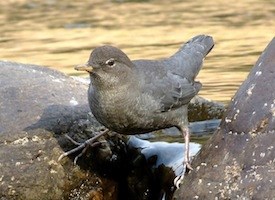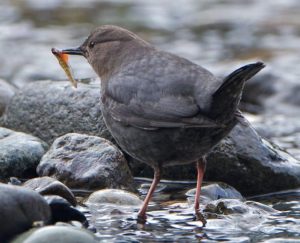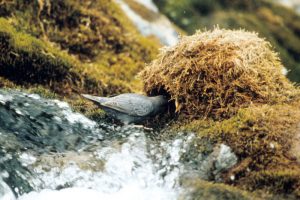The American Dipper (Cinclus mexicanus) is a curious species of songbird, it manages to catch the attention of many humans (myself included) even without an eye for birding. I first stumbled upon the dipper at the Nanaimo River on a warm summer evening, its charming song and hilarious in-stream antics provided a good source of entertainment during my visit. The Dipper is aptly named as it bobs up and down searching for food along stream-beds as seen below:
This is “North America’s only truly aquatic passerine,” (the Order containing perching birds). It mainly lives in stream habitats, but has also been found in lakes and seaside. Its year-round range extends from Alaska all the way to Panama, on the Western half of North America (Kingery and Wilson, 2011).
Adult Dippers are gray stocky birds, with long legs and short wings and tail. They are fairly small, ranging from 43-67 grams (about the weight of two AA batteries), and about 14-20 cm long. The males and females of this species are indistinguishable, and the young are similar in appearance, making them easy to identify at all stages of their lives. More like waterfowl than other songbirds, the American Dipper molts its wing and tail feathers simultaneously, leaving it flightless for a period of time. (Kingery and Wilson, 2011) The oldest recorded American dipper was at least 8 years old (Longevity Records of North American Birds, 2017).
American Dippers eat a multitude of critters, but the main portion of their diet is made up of aquatic insects including caddisflies, mayflies, beetles and mosquitos. They have also been known to eat worms, snails, small fish and fish eggs, essentially anything found in or around their river habitat (Kaufman). Their eating behaviours are a major part of what makes them unique, as mentioned before, they are the only true aquatic perching-bird in North America, this means that they dive and swim in order to catch a large portion of their food. They not only survive, but thrive in the rough currents, rapids, and rocky terrain of fast flowing streams. During the winter, the cold mountain water is no match for the dippers’ many feathers, their ability to carry extra oxygen in their blood, and their slow metabolism (Kingery and Wilson, 2011).
The American Dipper builds its nest up high in locations safe from predators, and flooding. Due to the nature of its habitat (rivers), this often means nests are built on cliff banks and in rocks and roots up above deep parts of the stream; In populated areas they are often built under bridges. The dippers are cooperative, and both males and females contribute to nest building. Their nests are sphere-shaped and are composed of two layers, an outer shell of moss and an inner chamber of grasses, leaves and bark. Each component of the nest is in water before being used and once complete, the inside of the nest is kept dry by the grass, while the moss absorbs and transports water to the exterior of the nest. (Kingery and Wilson, 2011)
For more information on the migration habits and the effects of stream-borne chemicals on the American Dipper, please see my second post
References:
Kaufman, K. Adapted from Lives of North American Birds. Guide to North American Birds: American Dipper. Audubon. Retrieved October 25, 2017: http://www.audubon.org/field-guide/bird/american-dipper
Kingery, H., and Wilson, M. Birds of North America: American Dipper. The Cornell Lab of Ornithology. 2011. Retrieved on October 27, 2017: https://birdsna.org/Species-Account/bna/species/amedip/introduction
Longevity Records of North American birds. U.S. Geological Survey. 2017. Retrieved on Oct 30, 2017: https://www.pwrc.usgs.gov/bbl/longevity/longevity_main.cfm



What a curious little bird! Great job with your blog!
I was wondering, is the American Dipper a migratory species? If so where is their breeding ground?
Thanks! As noted in my next blog post, they do not do conventional latitudinal migration, but some dippers do migrate altitudinally to breed and exploit new nesting sites upstream when the weather is warmer.
This is really well done! I was wondering if the American Dipper is territorial? I have seen two dippers on the Englishmen river over the last two weeks and was wondering if the female and male stay together all year round? Hard to tell with these guys since they look the same.
Thank you! From what I read it seemed like they do compete for nesting sites during breeding season, but are relatively okay with nesting close together. During other times of the year they are more solitary. The Alaska fish and game department has information saying that often the same pair will mate year to year in the same nest, but if one mate doesn’t return they will often find a new site with their new mate. They have records of pairs that have been together for at least three years!
As for general density, it was also noted a record of 13 individuals in a 100 yard stretch of stream (in BC!)
https://www.adfg.alaska.gov/static/education/wns/american_dipper.pdf
Your comment in lecture brought me right to your blog! Glad I did to! Cant say I’ve ever seen these little guys before but I’ll be sure to keep an eye out! Just wondering, since they aren’t in your typical passerine ecosystem, are these birds subject to predation? Does the rapid current somehow protect them against any sort of potential predator?
-Brianna
Yes they are all over Nanaimo river once you know what to look for! This source says that they are often preyed upon by mink, marten, cats, great blue heron and even trout, so perhaps not many of the typical predators! It is also thought that their dipping behaviour may offer some protection from predation as it could help them blend in with their environment. They do have the advantage of building nests in nooks on cliffs and ledges offering a lot of protection from predators during nesting.
http://www.adfg.alaska.gov/index.cfm?adfg=americandipper.main
Interesting! Dippers are cool, misfit passerines. I didn’t know about their the synchronous moulting of their flight feathers. That’s an interesting coevolutionary trait with waterfowl. Fascinating!